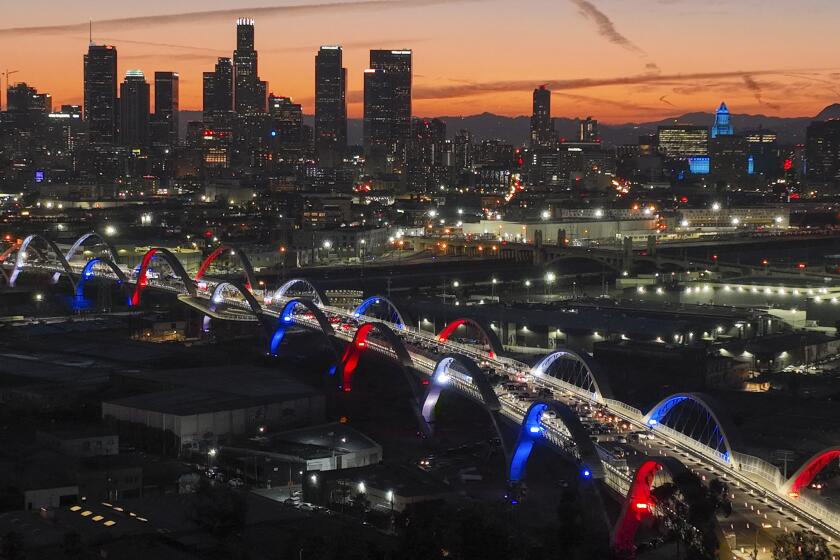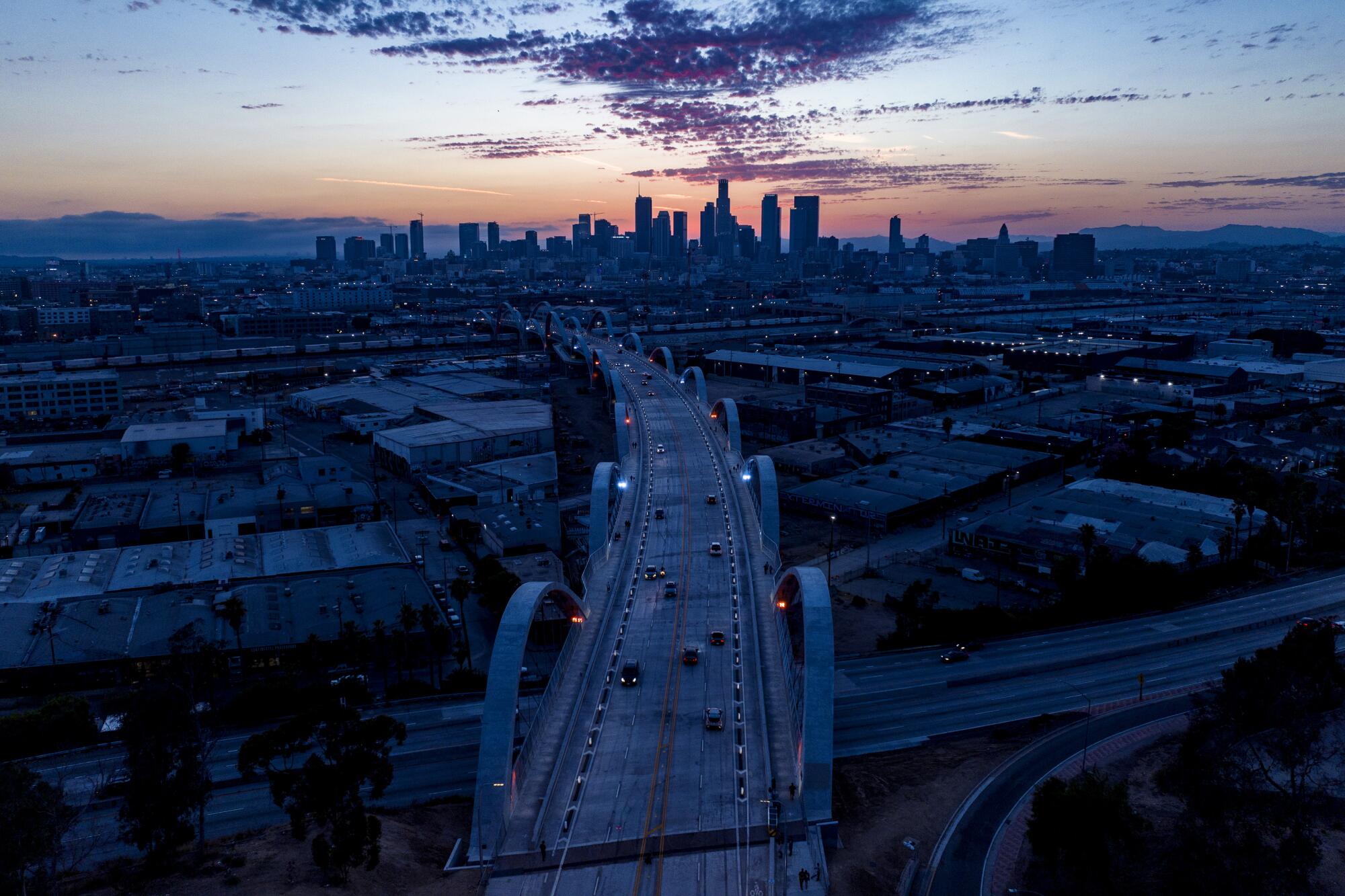
- Share via
In its short life, the 6th Street Viaduct has turned into so many competing things to so many people: Soaring civic landmark or roadway to gentrification. Altar to the city’s car culture or TikTok playground for general mayhem and lawlessness. Panoramic promenade for Boyle Heights abuelitos or glaring reminder of the lack of public space there and in so much of the city.
Basically, is it an architectural and cultural wonder or a symbol of so much that is wrong with Los Angeles?
The more-than-half-mile, $588-million span connecting the Arts District to the historic Eastside and Whittier Boulevard has become a new totem for the city’s fissures over transit, policing, housing, equity, culture and land use.
Eastsiders are worried about gentrification creeping in from downtown, transit advocates are upset over the unprotected bicycle lanes, and lowriders don’t want the racers on the bridge. Everyone wants to enjoy it in their own way.
“Since it’s opened, it’s become overwhelmingly clear that the community not only needs a functional bridge for cars to move across, but that there’s also a very real need for community public space,” said Betty Avila, executive director of Self Help Graphics, a nonprofit arts institution in Boyle Heights.
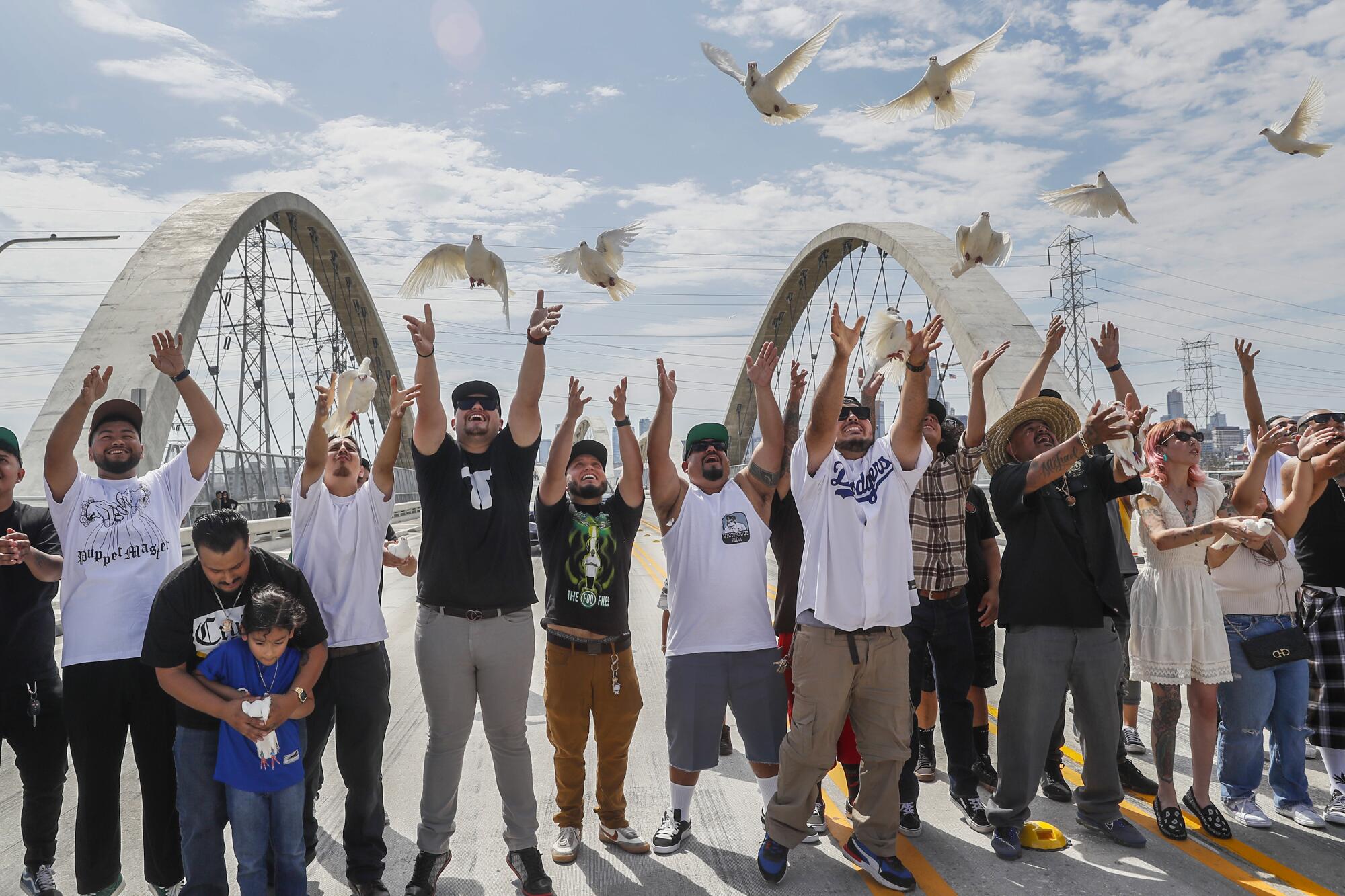
That was evident on a cool summer night last week, as teenagers skateboarded along the sidewalk, cruisers rolled by and pedestrians whipped out their phones to capture the iconic view of the city and the mountains beyond.
“It’s like the first time that we have something, because I feel like Boyle Heights is always being left out,” said April Campos, 32.
Coming from her home in Boyle Heights, she said she was “burning some calories” with her husband and 5-year-old daughter as the setting sun turned the pink sky a deeper shade of blue. The takeover drivers and daredevils climbing the bridge on the weekend, she said, “aren’t even from here.”
Chris Rosas walked along the bridge with his friends Javier Duran and Angel Rodriguez. Rodriguez had been filming the pair performing covers of popular Mexican songs.
“It’s fresh. It’s something new to the city. There’s a zest to it,” said Rosas, who is from La Mirada and known by the stage name Khris Ro. “It’s been a while since we have something like this and it’s unfortunate people are messing it up.”
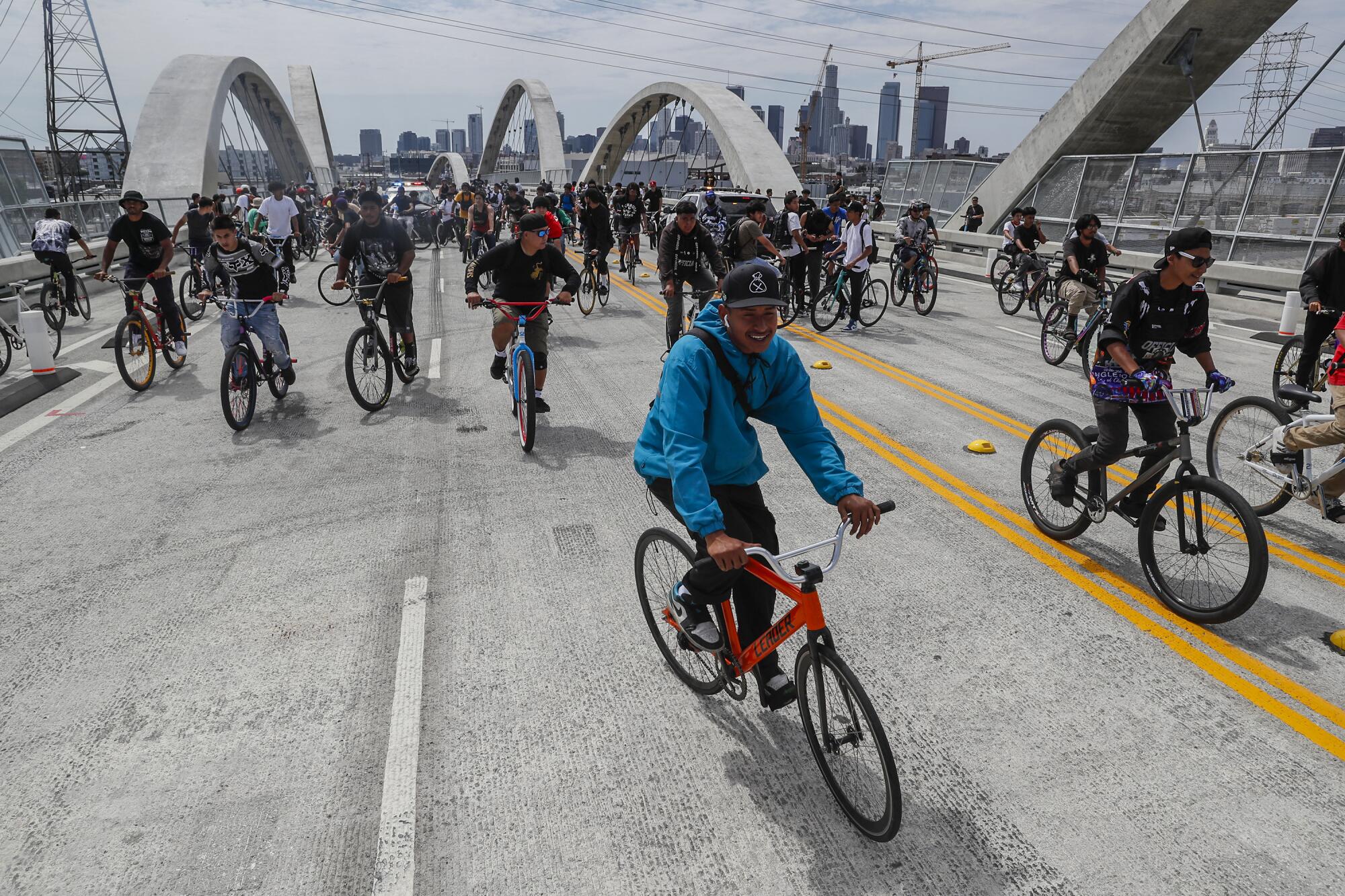
Rodriguez said he came to capture not only the stunning sunset but also the hype. “We thought we could go a little extra viral since there is so much media covering it.”
Rodriguez later said the strategy worked; the trio wound up on a local Spanish-language station.
Perhaps never has a bridge — at its core designed to carry cars and trucks across a concrete river channel and withstand earthquakes — been required to accommodate so many different interests, most notably from the overcrowded neighborhoods to the east.
City officials hope the new 6th St. Viaduct will be a venerable icon like the Golden Gate. But Los Angeles has a way of spinning its own stories.
Predominantly Latino Boyle Heights is considered park-poor and in “very high need” of more open space, according to an assessment from the Los Angeles County Department of Parks and Recreation.
On weeknights families with strollers saunter between sightseers taking photos, getting fresh air from the elevated deck. Their own parks are often dark at night, unwelcoming for some walkers and joggers, compared to the brightly lighted bridge filled with so many people.
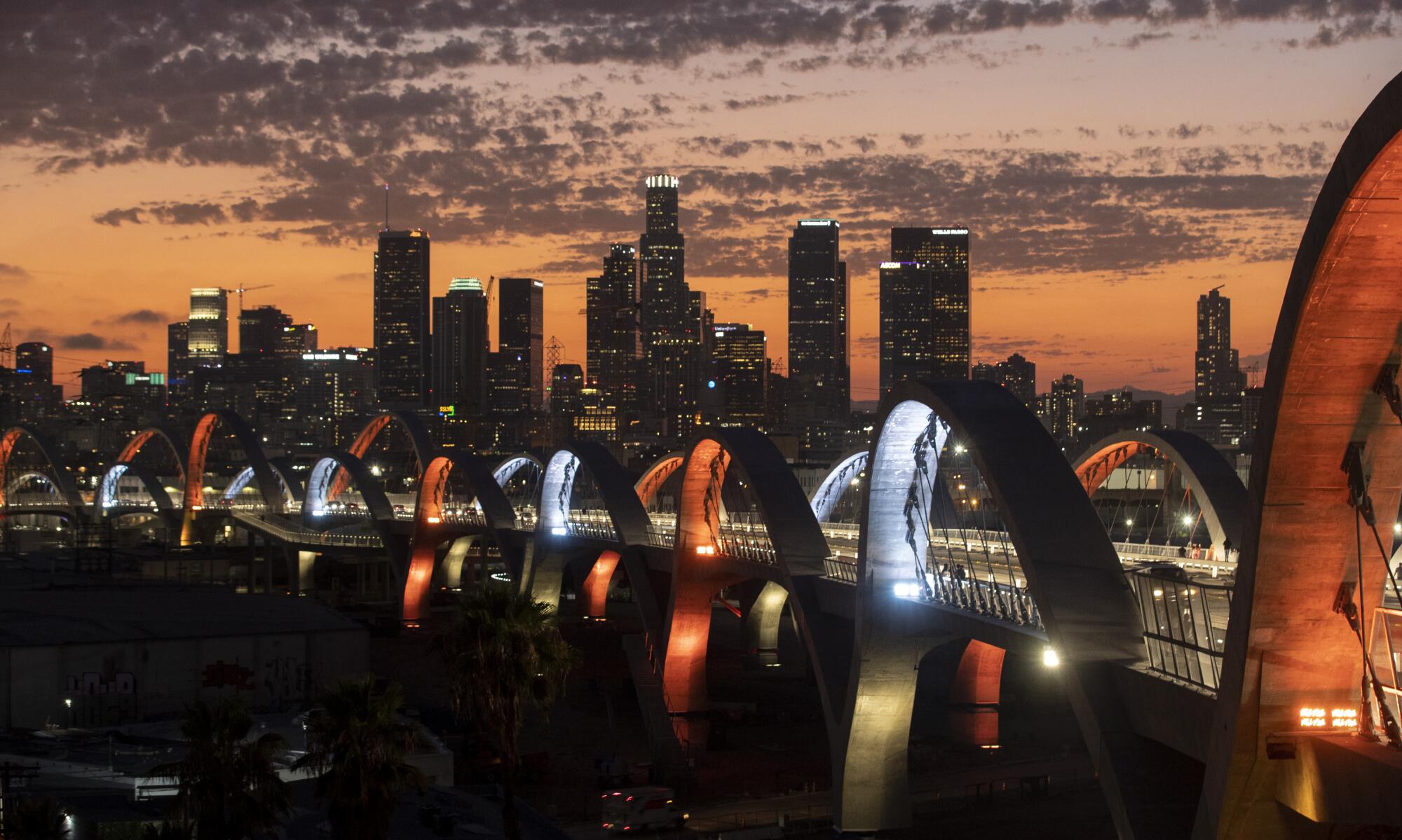
“We actually didn’t just build a bridge to replace the old 6th Street bridge,” said Eastside Councilman Kevin de León. “We actually have elevated open space that we can utilize in a much more creative manner — what we didn’t do in the past.”
Last week, De León introduced a motion that would calculate the cost of occasionally shutting down the bridge to cars and opening it to bicyclists and pedestrians. The effort, he hopes, could lead to more regularly closing the bridge to traffic.
“The idea that Fridays, Saturdays and Sundays are open space,” he said. “That’s an idea to float.”
He has also asked the city attorney to prepare an ordinance that would specifically target street takeovers, drag racing, stopping along the road and climbing the bridge’s 10 twin arches.
Some activists embrace the idea of closing the bridge to traffic altogether, arguing that its problems are the fault of the city failing to fully embrace how the people in that area would use the infrastructure. One of the biggest complaints is that the bicycle lanes along the span weren’t fully protected like the pedestrian walkway, which is lined by a low concrete wall.
Sahra Sulaiman, a writer for StreetsblogLA, which reports on issues related to reducing car dependency, said the cycling lanes seem as though they were designed for riders in Lycra shorts with high-end bikes riding close to the speed of traffic. She said it was not designed for the day worker, the “jornalero that’s trying to get on a mountain bike that’s not in the greatest shape and who’s not moving that quickly.”
Sulaiman, who covered the bridge planning for the website, said questions about use too often got swept aside.
With its 10 pairs of tilted arches, it is the largest and most expensive bridge the city has ever erected.
Over the last three weeks, it’s been closed several nights — including a four-night stretch — as the Los Angeles Police Department cracked down in an effort to fend off takeovers and rowdy bystanders, most recently on Sunday. But the bridge’s allure keeps drawing crowds, as shots from the picturesque span flood TikTok and Instagram feeds.

There was a quinceañera photo shoot, a man giving a tattoo, a barber cutting hair in traffic along with climbers and skaters who scaled death-defying heights. At the epicenter of influencer culture, its celebrity can’t be contained.
And costs for caring for Los Angeles’ latest star are starting to rise.
The LAPD has ramped up patrols and assigned extra officers. And last week, city officials estimated it would cost $704,000 to clean up graffiti on the bridge for a year. The graffiti-cleaning resources rankled City Council members from the San Fernando Valley, who say it was coming at the cost of their constituents.
“How is it that we can seemingly find unlimited funding to keep this half-a-billion-dollar bridge looking good? And we can’t find money for Canoga Park or the rest of the Valley or all sorts of parts of the city,” Councilman Bob Blumenfield said at committee meeting last week.
The viaduct replaced a popular Streamline Moderne bridge built in 1932 after it suffered from what engineers called “concrete cancer” that left it continually crumbling.
Eugene Hernandez, a longtime member and officer of the lowrider Imperials Car Club, attended its closing. He hasn’t been out to cruise his candy blue 1976 Chevy Caprice on the new span in part because of all the antics. Like other cruisers, he’s frustrated.
“I haven’t gotten to the bridge only because there’s been a lot of stuff that’s been going on with police presence,” he said. The retired Los Angeles Unified School District administrator said he plans to go cruising, but he’s also angry at the racers, the climbers and the others who are “not respecting the new construction or the new icon that we have in the city of L.A.”
“It’s disgusting,” he said.
Many fear the bridge will be an entree for wealthier people moving into the neighborhoods around it, raising rents and pushing longtime residents out.
“I’m very concerned about this bridge,” said Josefina Lopez, the founding artistic director of CASA 0101 Theater in Boyle Heights.
“We made it so beautiful, and so welcoming, and saying, ‘Oh, look, now it’s ready for you white people with lots of money,’” she said. “So don’t worry, keep going and keep moving into this neighborhood. It’s cheaper rent than what you’re paying.”
Lopez, a former city arts commissioner, said she has long worried about whether the city fully took into consideration how people would use the viaduct. But now that it’s up, she said, it’s cemented in our landscape for better or worse.
“I was driving it toward downtown, you look like you’re entering the Emerald City because it’s so beautiful and it’s so white,” she said. “Coming back was a different experience. You could see the [burnout] marks, as if they were tattooed on the bridge. I think everyone was trying to make their mark, you know — feel connected.”
More to Read
Sign up for Essential California
The most important California stories and recommendations in your inbox every morning.
You may occasionally receive promotional content from the Los Angeles Times.


